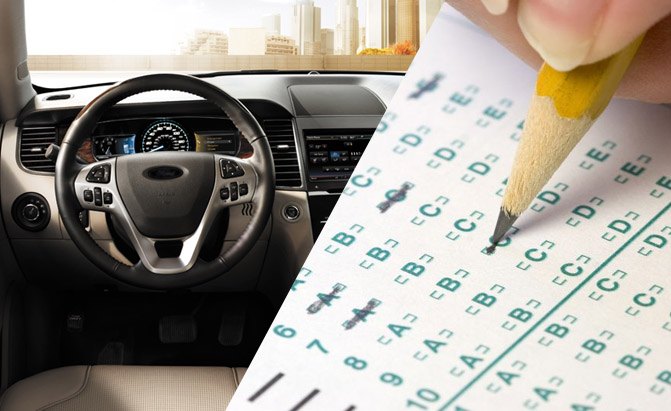Driving Test Tips: What You Should and Should Not Do

You’ve worked your way through driver’s training, studied the rules of the road and even know how to use a roundabout. You’re well on your way to getting a license, but you’re not there just yet. To avoid failing your big exam here are a few common reasons people don’t pass a driving test and some tips to avoid these pitfalls.
What NOT to Do
Surprisingly, statistics covering driving-test failures aren’t necessarily tracked by local or federal government. “Personally I’ve not seen any specific lists from states that describe why people would not pass an exam,” said Dr. William Van Tassel, manager of driver training programs at the AAA national office. Though he also said, “There are certainly some obvious mistakes on a driving test that would result in an instant fail.”
“If you cause a collision,” Van Tassel said, “You’re not going to be making it through the test.” Of course speeding, tailgating and ignoring stop signs are obvious no-nos, though he also mentioned that some states do not like it if you bump a curb while making a turn.
Some of these are rather silly reasons to fail a driving exam but Van Tassel said it’s “a little bit surprising how often that happens.”
SEE ALSO: Do I Really Need Premium Gas?
Responding via e-mail, Cindy Ferek, a teacher at Turner Ashby High School in Bridgewater, Virginia and a driving instructor said, “People often fail driver’s tests because they think driving is a lot easier than it appears to be. Many times teenage drivers fail because they have little to no experience behind the wheel.”
According to Ferek, practical training is critical. She said, “[Teens] typically try to memorize written materials versus practicing in a hands-on environment.” This can cause problems when it’s time to hit the road. Additionally, she said young people will often mimic the driving habits of their parents, which aren’t necessarily the best.
Of course taking time to study for the written portion of a driving exam is extremely important to a successful outcome. Ferek said they “can be tricky.”
Common Driving Errors
Van Tassel said failing to maintain situational awareness is another issue for many drivers. It’s important to know what’s going on around your vehicle at all times. Checking the mirrors, keeping an eye out for side-street traffic or pedestrians are all things that can prevent a deadly crash.
Finally, Van Tassel said another major error is “failing to adjust to the driving conditions.” If it’s raining or especially if there’s snow on the road it’s important to slow down, as stopping distances can be greatly lengthened. A lot of drivers may reduce speed during inclement weather, but often not enough.
How to Pass with Flying Colors
To help drivers, both young and old pass an upcoming exam Ferek said most DMVs across the country have booklets that are loaded with useful information. “I highly advise people to study this manual as most of the questions on the written portion of the test are pulled directly for this source.”
“I also highly recommend parents take their permitted teen driver(s) out as much as they can before they take their test,” said Ferek. “At the end of the day it’s about the hours and mileage you can get behind the wheel.” Practice makes perfect and the more you can get, the better off you’ll be.
Beyond these practical suggestions it also helps to be aware of any unusual requirements in your area. Van Tassel said, “In some states they don’t care what you do,” though obviously this isn’t the case everywhere in the Union. “Oregon has a strong program for instructor training, public funding and the curriculum for what the teens experience,” he said, describing it as the “brightest state at this point” when it comes to driver education.
The Future of Driver Training
Curiously there’s no national standard in the U.S. for teaching motorists so things vary widely from one state to another. Arguably the current patchwork of rules and regulations leaves much to be desired.
Van Tassel said, “We definitely need improved driver education.” However, he’s doubtful we’ll ever get to the complexity of some European countries. Germany for instance has notoriously difficult and expensive licensing standards.
ANSTSE would like to see education averages increase to 45 hours of classroom training and 10 hours behind the wheel. But unfortunately at this time Van Tassel said these are merely suggestions as, “There’s no enforcement behind them.”
Moving ahead, Van Tassel said some states are implementing new processes for driver education. Ohio for instance is experimenting with computer simulations to help weed out motorists that aren’t ready for a proper road test. This “could be a time saver, a money saver” he said, in addition to something that expedites service at DMV offices.
Making the Grade
Regardless of what your particular state requires, there are a few keys to passing a driver’s test. First, fate favors those that are prepared. Make sure to study the rules of the road and hone your skills by getting as much practice behind the wheel as time permits. Finally, as in life, a little common sense goes a long way, so keep your eyes on the road and hands on the wheel.
Check out our Tips and Advice Section.

Born and raised in metro Detroit, Craig was steeped in mechanics from childhood. He feels as much at home with a wrench or welding gun in his hand as he does behind the wheel or in front of a camera. Putting his Bachelor's Degree in Journalism to good use, he's always pumping out videos, reviews, and features for AutoGuide.com. When the workday is over, he can be found out driving his fully restored 1936 Ford V8 sedan. Craig has covered the automotive industry full time for more than 10 years and is a member of the Automotive Press Association (APA) and Midwest Automotive Media Association (MAMA).
More by Craig Cole




































Comments
Join the conversation
One more thing for new drivers: after you get your license, don't stop learning how improve your driving skills. I think a lot of new drivers believe that they have no need for additional training.
If drivers are having a difficult time adhering to the law against distracted driving,